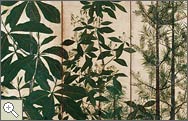
Rice Growing and Processing
Rice cultivation was introduced to Japan from other Asian countries by the fifth century B.C. Today, rice grows on almost half of the cultivated land in Japan. The climate in most areas of Japan allows for one crop of rice per year.
Long ago the Japanese believed the rice plant was a gift from the gods. For hundreds of years the difficult work of growing rice was done by hand, but now much is done by machine. However, the number of hours of labor per acre is still very high, about 330 hours per acre in 1975. This is about forty times the number of hours of labor needed per acre for the production of corn in the United States.
Farmers start rice seeds in small plots of dry land, but the plants need to grow in shallow water, so they build low walls to form a paddy around a field. Pipes bring water from a nearby river to flood the field artificially. After three or four weeks, farmers transplant the young plants to the paddy. The fruit, a grain, is at the top of the stalk. When the rice is ripe, it resembles the oat plant and is golden yellow.
Farmers drain the paddy to harvest the rice. They cut the stalks, tie them in bundles, and hang them up to dry. When the bundles are dry, they thresh (beat) the rice and winnow it (toss it in the air) to separate the grain (the part that is eaten) from the outer brown husk. Finally the harvesters store the grain in bags. Rice is Japan's staple food and the plant's straw becomes part of many useful products such as hats, sandals, floor mats (tatami), wine (sake), and food for livestock. Huge ropes made of rice straw decorate entrances to shrines of the Shinto religion.
|
 |
 |
 |
 |

Trees: By Nonomura Sotatsu
|
 |
 |

Rimpa School, Momoyama-Edo period, seventeenth-century
Ink and color on gold leaf
Freer Gallery of Art
accession number 62.30
154.0 x 357.8 cm (60 5/8 "x 11' 9")
1997 Freer Gallery of Art, Smithsonian Institution
|
 |
 |
 |
|

